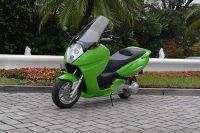Revolutionary Gas-Like Performance of Emission-Free Scooters with TI's DSP

Leveraging the efficiency of real-time, high-performance control, Vectrix Corporation has selected the TMS320LF2401A™ digital signal controller from Texas Instruments (TI) (NYSE: TXN) for its revolutionary electric motor scooters. By pairing TI's leading digital signal processing (DSP)-based motor control technology with a high performance, custom designed brushless servo motor from Parker SBC, part of the Parker Automation division, the new lightweight Vectrix scooter delivers a level of performance and acceleration typically only found in a 250-cc gasoline-powered motorcycle. Vectrix's scooter achieves this gas-like performance without the polluting emissions typically found in two stroke gas engines.
The LF2401A controller is ideal for applications that require the high-performance of TI's leading DSP technology along with the peripheral integration and ease-of-use typically found in a microcontroller (MCU). TI's DSP-based controller helps Vectrix's scooter motor operate more efficiently and at a higher level of performance than traditional MCUs or analog designs. This increased functionality and efficiency gives Vectrix a valuable edge in developing lightweight, inexpensive solutions for electrically powered transportation that rival gas-powered options and are environmentally friendly.
"We began development using traditional microcontrollers (MCU) for motor control, but quickly switched to TI's LF2401A when we realized we needed a highly integrated digital signal controller to reduce the size and complexity of the scooter's electronics system," said Peter Hughes, vice president of technology, Vectrix. "Thanks to these benefits, plus the flexibility inherent in programmable digital technology, our overall development was simplified, and we were able to pack all of the scooter's control functionality onto a single board."
The LF2401A also enables Vectrix to implement advanced motor control functions such as tuning the motor's phase angle advance, which would be difficult if not impossible to implement using analog circuitry or a standard MCU. These functions enhance Vectrix's scooter performance by providing up to 75 miles (120 kilometers) of travel at 25 miles per hour (40 kilometers per hour) before the battery has to be recharged. The programmability of the LF2401A makes it possible for Vectrix to tune their system for a wide variety of motors and performance characteristics, providing optimum performance for a wide range of scooter models.
Software programmability will also reduce hardware design time for new Vectrix products by enabling the company to develop scooters with different features and performance ratings based on the same control platform. In addition to motor control, the controller handles system startup, lights and safety, and battery recharge management and supervision. External communications can also be supported for future vehicle requirements.
"We are excited to provide Vectrix with this level of motor control processing power and performance to make cost-sensitive and environment friendly features possible on these electric scooters," said Jennifer Skinner-Gray, C2000™ worldwide marketing manager, TI. "As in many cases, digital signal processing technology is often needed to take next generation applications to the next level of development."
Electric motors provide an alternative to heavily polluting two-stroke gasoline engines, which are widely used in scooters throughout Europe and Asia. The World Bank estimates that 60 percent of the total vehicle fleet in Southeast Asia is powered by two-stroke engines, each of which is estimated to produce far more pollution than a large number of properly maintained four-stroke automotive engines.
Parker SBC teamed with Parker’s Electromechanical Automation division to design the direct-drive brushless direct current (DC) motor specifically for this application, which peaks at 20 kilowatts with currents up to 300 amperes and 65 Newton meters (Nm) of torque to provide exceptional acceleration of zero to 50 kilometers per hour (km/h) or zero to 30 miles per hour (mph) in 3.6 seconds. The motor configuration is optimized for space constraints, while the motor is optimized for cruising and high acceleration. The motor also features a high pole-count design for maximum torque per watt, an innovative single-tooth segment winding for higher reliability, automated assembly and lower cost.
Prototypes of the Vectrix scooter are now being test-driven on the streets of major European cities. Production manufacturing is scheduled for spring 2005 for Europe, with Asia and other regions to follow as the scooter demonstrates its success.
Source: Texas Instruments















